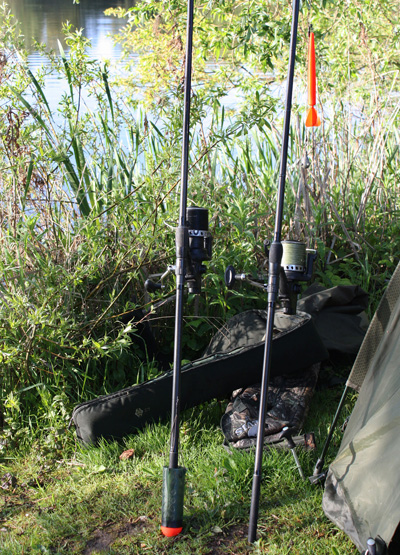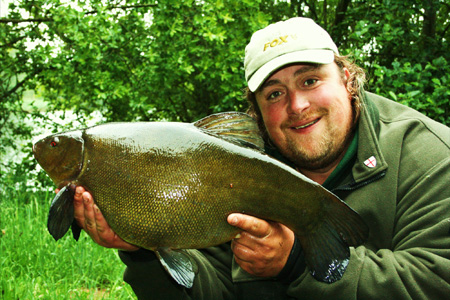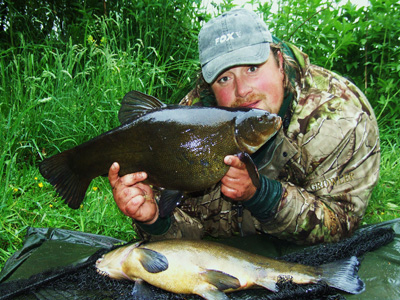Location, location, location.
Having looked at everything we need to do to catch tench in the first two parts of this series in this final part I intend to look at how we go about the process of catching tench on a regular basis.
There is an oft quoted phrase that you cannot fish far enough out for bream or close enough in for tench and there is much truth in that. The margins of any lake are a huge feature and will attract tench but, contrary to popular belief, I have, in my experience, found it a patchy feature at best.
Shallow margins, I find, tend to be quite useless; however where the fish do have a bit of water over their heads the reverse is often true. At the moment I fish two waters for tench regularly: one is over twenty acres, has margins of varying depths but far more features and, just as importantly, weed out in open water, the second only has deep water in one narrow band along one margin. On the first water I have never caught a tench in the margins despite many attempts; on the other I don’t catch them anywhere else!
I never ignore the margins completely as they offer the chance to use float tactics, which I far prefer, but in all honesty if I was restricted to float fishing only then I believe that I wouldn’t have caught half as many big tench as I have. On the forum after the last article Dangermouse criticised my article for covering legering in depth and I got the impression that he didn’t like the method at all, well maybe now he can understand why it is such a pivotal part of my tench fishing?
So, moving away from the margins, what do we need to look for in respect of the areas that will hold tench and where they will feed? Well, I would say that being a pretty active fish just about anywhere will hold them but there are certain features that produce better results than others.
To my mind absolutely top of this list is weed. Tench adore the stuff and are rarely very far away from it. It not only contains the food they are want to eat, but also provides cover from predators, both above and below the surface.
 Now there is weed and there is weed and knowing that tench love weed is all well and good, but you have to in some way not only present a bait to the fish there but also safely extract the fish that you hook from it. Therefore you need to become proficient with a plumbing rod and with the technique of leading around your swim to find its features. Don’t think that a bait boat with an echo sounder will do this for you. The echo sounders on a bait boat are only of sufficient quality to map the bottom. Even more expensive and powerful units struggle to tell you the depth of weed and, even when they can, they won’t tell you what type of weed it is, how dense etc.
Now there is weed and there is weed and knowing that tench love weed is all well and good, but you have to in some way not only present a bait to the fish there but also safely extract the fish that you hook from it. Therefore you need to become proficient with a plumbing rod and with the technique of leading around your swim to find its features. Don’t think that a bait boat with an echo sounder will do this for you. The echo sounders on a bait boat are only of sufficient quality to map the bottom. Even more expensive and powerful units struggle to tell you the depth of weed and, even when they can, they won’t tell you what type of weed it is, how dense etc.
Learn to use a plumbing rod properly and it will teach you miles more than any echo sounder ever will. As an example I have yet to find a way of fishing for tench in thick Canadian Pondweed and, as such, I try to avoid fishing too close to really thick beds of it as it is also very difficult to get big tench back through it. Finding dense Canadian Pondweed therefore has me looking around the swim for other areas.
Eel grass, on the other hand, is a completely different matter. With the use of a PVA bag a bait can easily be fished amongst this, especially when the shoots are just a few inches high but what I am really looking for is an area of thin or no weed amongst an area of steady growth. Usually there are plenty of such features on a water if it has gravel bars, plateaus and ridges. Hard gravel doesn’t promote good weed growth and it also holds very little in the way of natural food so it wouldn’t normally be on a tench’s natural feeding patrol route, other than as somewhere that they may be passing by.
Of course by pre-baiting we can influence the fish’s behaviour to the extent that it considers such areas a natural feeding spot, but if you can’t do this regularly enough then you need to be fishing amongst the thinner weed where the tench will expect to find food and where they will be actively looking for it. These are more certain spots as the fish expect to find food there; on areas created by baiting they are naturally going to be cautious, at least initially, of a ‘new’ area springing up from nowhere. Now, which is the easier to catch of those two tench?
 Once I have found a likely spot with a marker float what I do next is to take off the hooklink of the rods I am going to use and cast them around the marker float to gauge exactly what type of bottom weed it is, how thick it is and how large the area is so I can decide how many rods to put on it. Once I have the bait where I want it I mark the line by tying on a short piece of luminous pole elastic and clipping the line up at this mark. Once all three rods are ready I then begin to introduce some bait. Usually this is done by the means of a spod, but occasionally I borrow a bait boat. The better way though, I feel, is the former as you get a better spread of free offerings making the tench move around more often and as such more likely to get themselves hooked as tench are notorious for sussing out the most technical of rigs when they have the chance, the best way to combat this is a bit of competition and bait not fished in too tight a patch.
Once I have found a likely spot with a marker float what I do next is to take off the hooklink of the rods I am going to use and cast them around the marker float to gauge exactly what type of bottom weed it is, how thick it is and how large the area is so I can decide how many rods to put on it. Once I have the bait where I want it I mark the line by tying on a short piece of luminous pole elastic and clipping the line up at this mark. Once all three rods are ready I then begin to introduce some bait. Usually this is done by the means of a spod, but occasionally I borrow a bait boat. The better way though, I feel, is the former as you get a better spread of free offerings making the tench move around more often and as such more likely to get themselves hooked as tench are notorious for sussing out the most technical of rigs when they have the chance, the best way to combat this is a bit of competition and bait not fished in too tight a patch.
Other areas to look for aside from those talked about in detail are gravel bars, slopes, and gullies, deep holes and plateaus. The last of these are a particular favourite of mine as they offer all round the clock possibilities. During early morning the bottom and slopes are a good bet, but as the sun rises in the sky and the shallow water warms up so the tops of the plateaus become a good bet, therefore I tend to spread my rods accordingly, one on the bottom, one on the slope (when possible) and one on top.
Bait choices
Bait choice is always a source of discussion amongst most serious tench anglers, all agree that the best two baits are maggots and casters but as to which order is a definite talking point.
 Personally I have caught well on both but I tend to come down on the side of maggots as number one, especially red maggots. Whether or not the colour makes as much difference to the fish as it does to personal confidence is a matter of opinion, but I personally feel much more confident with a gallon of the red wrigglers at hand.
Personally I have caught well on both but I tend to come down on the side of maggots as number one, especially red maggots. Whether or not the colour makes as much difference to the fish as it does to personal confidence is a matter of opinion, but I personally feel much more confident with a gallon of the red wrigglers at hand.
For float fishing though I tend to prefer to use larger baits such as lobworms, prawns, sweetcorn or bread that are harder to fish on a hair or at range. As for free offerings hemp is always at the top of the list as tench adore the stuff, followed by wheat, pellets, groundbait, corn and dead maggots or casters.
One note on pellets to bear in mind though is that although tench adore halibut pellets the whole point of them is to feed and promote growth in farmed halibut. Thus they will fill fish up extremely quickly and therefore you do not really want to be using them in great quantities. These days I tend to use a mixture of different pellets both in type and size. This also has the advantage that the tench doesn’t come across the same food item time after time and get used to picking up one type of bait or get pre-occupied on one.
Fishing in weed
Finally, one bugbear of mine.
We all love tench and tench fishing but please be realistic about when and where you practice it. I’ve talked about fishing in weed, but hauling fish in on over-strong gear from very weedy waters is not big or clever and invariably causes a lot of damage to the fish you supposedly care about. If you do get a fish stuck in weed don’t just haul and end, in all likelihood, end up snapping off. Instead take your time, slacken off and watch where the line enters the water, as soon as the line starts to move, try pulling the fish clear with firm, steady pressure. Again don’t try and pull its head off, just keep firm pressure on the fish and it will usually kick itself clear with time but, most importantly, it will go back just as it was before, without a ripped mouth.
I hope you have enjoyed this mini series on tench and I hope it may put a few extra ‘red eyes’ in your net this summer. For me, with the river season just open, it’s now time for some river carp fishing and it’s this most exciting variant of carp fishing that I intend to lift the lid on in the course of my next few articles.
Tight lines.










